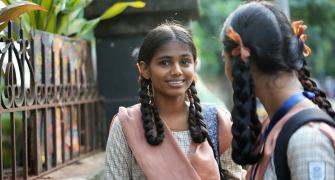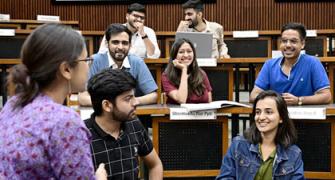The 18-year-old tennis player hit it big when she entered the third round of the Australian Open and went down to Serena Williams, but only after a spirited fight. Sania has emerged not just a superb sportsperson, but a youth icon, indeed a 'brand' in her own right. Advertisers are flooding her with offers to promote everything from mobile phones and processed foods to cosmetics.
As Alyque Padamsee, considered some kind of wizard in the advertising world, put it in a newspaper interview: 'Not since P T Usha has India had a female sports star of this calibre. Sania is young and hasn't yet achieved (her) full potential. So I feel she is an advertiser's dream. She can become a superstar and an icon for youth Soon, there will be 'Sania mania' sweeping the land!'
Sania Mirza: India's new sporting star
Marketing gurus already see Sania Mirza as a role model for the young. She personifies the 'new India' -- someone with tremendous energy and self-confidence and the desire to achieve and excel. Besides, says an adman: 'She is good-looking, young, athletic, gutsy and consistent She is on a roll. She is very hot for the advertisers.'
Apart from glamour, Sania Mirza possesses a simple, wholesome charm that comes out of sheer earnestness. There is a down-to-earth quality to her, which goes beyond the transitory appeal typical of models. Unlike actresses, Sania is 'real.'
Even before her Australian Open debut, Sania Mirza endorsed five brands including GVK Industries, her first sponsor, Atlas Cycles, Tata Tea, Sahara and Sports Authority of Andhra Pradesh. Now, she will probably do a few more. More important, she has been appointed ambassador of the 'Save the Girl Child' campaign of the ministry of health and family welfare.
Remarkably, this is the first time that a Muslim woman has been assigned the role of raising gender awareness in a society which literally kills millions of female foetuses.
There lies the true significance of the Sania Mirza phenomenon.
She has come to embody a number of aspects of modernity, freedom and rationality -- the very opposite of the stereotypes that Indian Muslims are straitjacketed into. Many conservatives, especially Bharatiya Janata Party sympathisers, believe Indian Muslims are irredeemably backward, illiterate, overly religious, bigoted and resistant to change, especially in matters of dress, customs, personal laws, and family planning, and that they are incapable of breaking the stranglehold of the mullah and coming out of the burqa.
In their view, Muslims are somewhat inferior under-socialised human beings who deserve pity or sympathy, not equal treatment or respect. The Hindu nationalist as well as the middle class pseudo-liberal is deeply uncomfortable with the modern, liberal, educated, well-informed Muslim who has an open mind and cosmopolitan outlook. The discomfort is all the greater if the person is a woman.
Sania Mirza represents all of those modern attributes. And yet, she has become an irresistible, irrepressible icon by dint of her talent and her transparent charm. This is a major transformation of the Indian Muslim stereotype.
Exceptional as she is in her impact as an icon, Sania Mirza is by no means the sole Muslim to have made a mark in her/his field and defied the stereotype of incurable backwardness and social servitude.
The three Khans hold near-complete and unchallenged sway over Bollywood. Yet other Muslims have distinguished themselves in recent years in films: Shabana Azmi, Tabu, Saif Ali Khan, Saeed Mirza, Zayed Khan, Javed Akhtar. They no longer have to mask their identity as the earlier generation did by adopting Hindu names -- as with Dilip Kumar, Meena Kumari and Madhubala.
Similarly, in the field of sports, the achievements of Mohammed Azharuddin, Irfan Pathan, Mohammed Kaif, Zaheer Khan and Syed Kirmani are far too well-known to need recounting. Remarkably, to be recognised, these stars don't have to hide their Muslimsness or wear their patriotism on the sleeve. They can be 'natural,' they don't need to over-achieve.
But it is misleading -- and profoundly wrong --
- Sixty years ago, the richest Indian was the Nizam of Hyderabad, a thorough feudal who derived his authority and wealth from inheritance and, eventually, plunder.
- Today, the richest Indian is Azim Premji, chairman of Wipro Ltd, one of the stars in the Information Technology firmament. Wipro belongs to one of the most modern, internationalised, competitive and technology-intensive sectors of Indian industry. Unlike the Nizam, Premji is wedded to modern values and to promoting education. He earned his millions not through inheritance, but entrepreneurship. He is driven by a strong work ethic.
- Yet another high-performing industry in India is pharmaceuticals. Among its top-profile companies are Cipla and Wockhardt, both owned and managed by forward-looking Muslims. Dr Yusuf Hamied of Cipla is a Cambridge-educated chemist who runs one of the most dynamic research and development outfits in the drug industry anywhere. Cipla can produce anti-AIDS drugs at 1/50th the price at which US companies sold them until recently. It has become one of the most competitive producers of generic drugs in the world.
- Some of the topmost advertising professionals are Muslims, including Alyque Padamsee, Mohammed Khan, Muzaffar Ali and Rafeeq Ellias. This is a sophisticated quaternary sub-sector of the service economy.
- In modern art, it's impossible to ignore the pivotal importance of M F Husain, S H Raza, Akbar Padamsee, Ghulam Mohammed Sheikh and Tyeb Mehta.
Sania keen to inspire youngsters
The list can be greatly expanded. The point is simple. A significant modern Muslim intelligentsia has crystallised in varying fields, including academics (examples, Irfan Habib, Mushirul Hasan, Shahid Amin, Zoya Hasan), avant garde theatre (Habib Tanveer, Ebrahim Alkazi, Jabbar Patel of Ghashiram Kotwal fame, and Zohra Sehgal), literature (Faiz Ahmed Faiz, Ali Sardar Jafri and Kaifi Azmi), and journalism (M J Akbar, Zahid Ali Khan).
This intelligentsia is qualitatively different from the old Muslim aristocracy to which, say, the Nawab of Pataudi and Abbas Ali Baig belonged. It is an accomplished group of self-made liberal middle class professionals. Its sensibilities are quintessentially modern, secular and universalist.
These are not Muslim intellectuals as such. They are intellectuals first, Muslims second, by birth. The winds of modernisation and secularisation are sweeping through the larger Indian Muslim community to a far greater extent than is recognised.
Sania Mirza represents this very change. Most members of this modernising group are not deracinated or uprooted from traditions and customs. For instance, Sania's family is deeply religious. I spoke to Sania's father, Imran. He said: "We pray five times a day, read the Quran and observe rozas (fast) during Ramzan. My wife and I went to the Haj recently."
So it won't do to stereotype them as stray, isolated individuals detached from their community.
Imran Mirza and his wife are both graduates. He started as a sports journalist and went into printing. He is now a builder. Yet, he is sensitive to the criticism that Sania's tennis shorts violate what some consider the Islamic dress code. (He believes there's forgiveness in Islam).
Imran isn't wealthy. "It wasn't easy to put Sania through expensive training in tennis, even her racquets and shoes don't come cheap," he says. "We were lucky to have found a sponsor when Sania was 13." This was G V K Reddy -- a 'Hindu' business group.
The forces of secularisation and modernity are gaining strength among Indian Muslims.
A new awareness is growing about the importance of modern education as the key to the professions and government jobs. The Siasat daily of Hyderabad has done pioneering work in running teacher training courses, operating clinics, coaching students in science, medicine and engineering, and training young women for call centre jobs. Siasat has become the first Indian daily to set up its own Internet web site.
Similarly, Jamia Hamdard in Delhi has launched a successful programme to prepare young Muslims for the civil services. Other trusts are educating the Muslims about lifestyle issues, such as the virtues of a good diet, including a strong component of vegetables and fruits.








